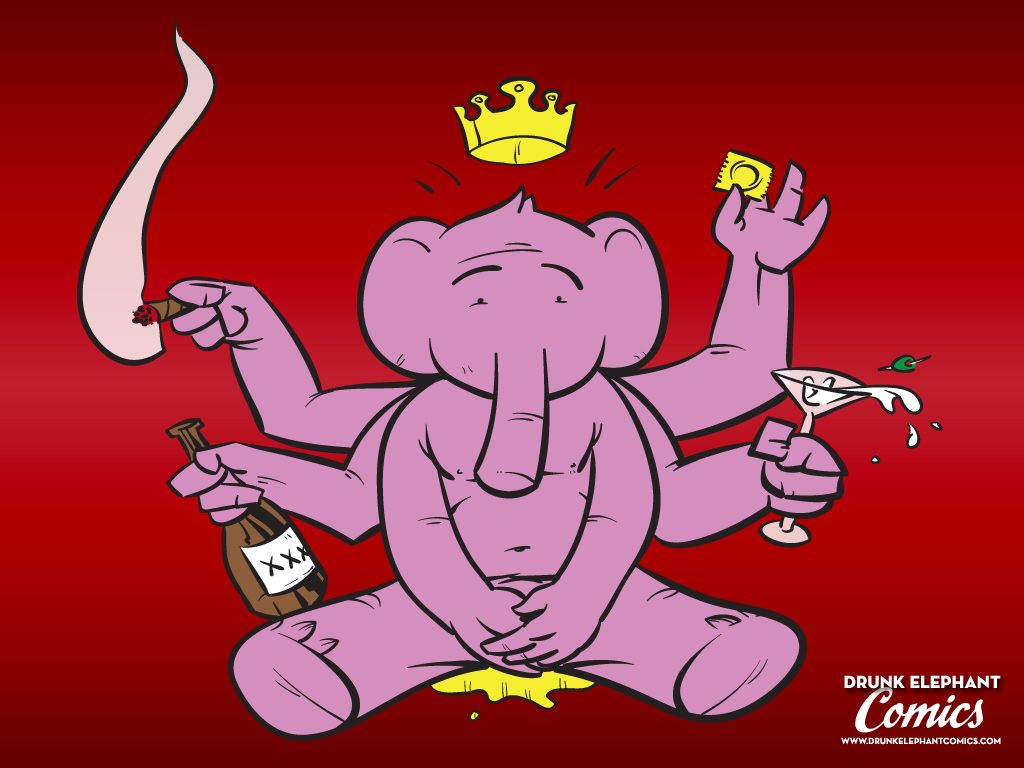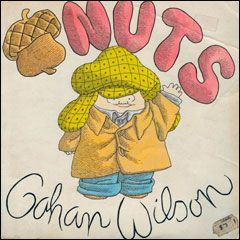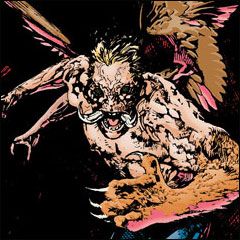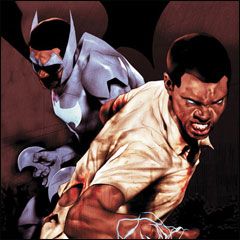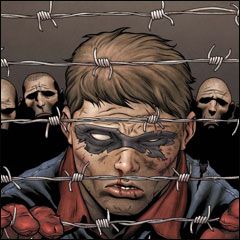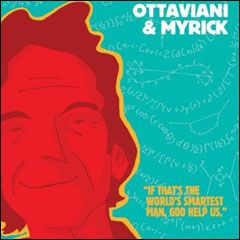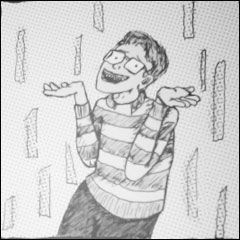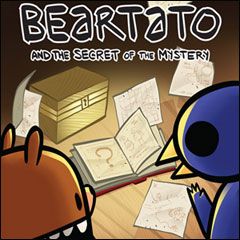Welcome to another edition of What Are You Reading?, your weekly look into our reading piles. Today we're joined by special guest Jacquelene Cohen, director of publicity and promotions for Fantagraphics Books.
To see what Jacq and the Robot 6 crew have been reading lately, read on ...
*****
Chris Mautner
Nuts by Gahan Wilson -- I've written at length about this strip before, but it's worth reiterating I think just how goddamn wonderful this comic is, and how great it is to have a decent collection available after lying fallow for so long. Wilson captures the anxieties and traumas of childhood as few cartoonists have before or since. Never one to grow nostalgic, Wilson understood perfectly well what an utter hell childhood could be and he sets about reminding readers just what it was like to experience your first death, or to be really sick, or to have to deal with that rich kid in your class who always got better stuff than you did and rubbed your face in it. My only complaint about the book is that some of the strips seem to be out of narrative order, but it's a small quibble. I'm just happy to see these comics back in print.
Pure Pajamas by Marc Bell -- This is a collection of early strips and comic stories Bell did for various publications back in the 1990s though, except for one or two segments -- it bears a pretty close resemblance to the sort of work he's doing now. Bell's comics always take place in a big-footed, anthropomorphic universe, where everything -- pills, the broccoli on your plate, a pair of pajamas -- seems capable of suddenly coming to life and doing a little song and dance. It's a vibrant, cartoony impeccably detailed world to be sure, but not one devoid of darkness. The broccoli could easily end up being cut to pieces and served on a plate of rice, cute little drunks can get crushed to death by speedy security wagons, you could be a piece of toast looking for advice from a psychiatrist only to end up as his breakfast. There's a bit of danger and savagery in Bell's world, which gives the stories in Pajamas a nice bit of tension and keep the whimsical nature of his universe from getting too precious.
Tim O'Shea
Animal Man #3: The second issue had sold out at my local shop, so this week I caught up reading both issue #2 and #3. This is a title that I bet would have been a great success for Vertigo in the old DCU. But in the new DCU, I wonder if it will have sales levels that will make the bean counters happy. Had it been a Vertigo book, the lower numbers (that I speculate will greet this book eventually) would be fine. Anyways, as for the series itself, it really has turned Buddy Baker’s origin inside out (literally and figuratively), while still keeping the Baker family as a focal point (much like my favorite era of the character, when written by Grant Morrison). As much as writer Jeff Lemire is boring me on Sweet Tooth these days (though the latest installment of the Matt Kindt arc was substantially more interesting to me than the first part), he is delivering a strong script on this book. Meanwhile, I imagine that Travel Foreman’s art is earning him a plethora of new fans. The reason the art is so striking is the distinctive coloring efforts of Lovern Kindzierski.
Stormwatch #3: Again, issue #2 had sold out so this week found me catching up on two issues of the new Paul Cornell incarnation of the former Wildstorm property. Cornell approaches this title with his Doctor Who series writing sensibilities—and it works. There’s a solid balance of adventure and whimsy to the overall narrative. And artist Miguel Sepulveda is the ideal match for Cornell, as exemplified in the opening scene of the latest issue, where Jack Hawksmoor grabs a cup of tea (or is it coffee) mentally with the cities of Metropolis (a meter maid?), Paris and Gotham (a gargoyle). When I read that scene, the series most definitely clicked with me (unlike Cornell’s Demon Knights, I might add, which has failed to spark my interest to any substantial degree).
Batwing #3: I cannot believe that Judd Winick is writing such an incredibly engaging title as this. I can only speculate part of the credit goes to him being properly edited, so kudos to Mike Marts. I hope that the series eventually builds a supporting cast beyond one or two folks. Unfortunately, so far, the mortality rate on folks that have appeared so far is fairly high.
Hulk #44: Damn you, Jeff Parker, for making Machine Man the perfect sidekick for Hulk. This comic never disappoints me.
Villains for Hire #0.1: Reflecting upon the strengths of the former Heroes for Hire series, the series had a good sense of humor amidst the characters, thanks to writers Dan Abnett and Andy Lanning . That sense of humor carries on in the initial installment of the new incarnation of the series. For example, the whole Stilt Woman going with the Stilt Man name was a great bit that worked for me.
Captain America and Bucky #623: Smarter Cap scholars than me will remember past issues where the topic of the WWII concentration camps were addressed (though I just recalled Chris Claremont/Roger McKenzie’s introduction of Anna Kapplebaum in Captain America #237). I have to give writers Ed Brubaker and Marc Andreyko credit for conveying the impact it would have on Marvel heroes (in this case Bucky and Toro) in realizing the full scale of the horrors of the camp. The strength of those scenes only works however, due to the effective collaboration between artist Chris Samnee and colorist Bettie Breitweiser.
Brigid Alverson
I read Jimmy Gownley's latest Amelia Rules book, The Meaning of Life and Other Stuff, and I'm not ashamed to say it made me tear up a bit at the end. This is the seventh book in his series about Amelia McBride, who moves from New York to a small town after her parents divorce, and while the first books were all about adjusting and making friends, in this one, Amelia is seeing the new reality crumble a bit. Amelia is surrounded by warm, loving people, except for her bully of a principal, but that doesn't mean there is no tension and emotion in this story; Gownley is a perceptive observer of the small moments and gestures that can strengthen or strain a friendship. He is also one of the best cartoonists around, and he stretches the medium in interesting ways, but only in the service of the story. The Meaning of Life is about kids, and kids generally like the Amelia books, but it's a very satisfying read for a grownup as well.
I'm about halfway through Jim Ottoviani and Leland Myrick's Feynman. This is a book that is close to my heart: My father, a theoretical physicist, gave me a copy of the Feynman Lectures when I started college, and my husband, an experimental physicist, actually had Feynman as a professor at Caltech. The graphic novel does a nice job of balancing Feynman's life and work, presenting him as the interesting, quirky guy that he was as well as explaining his work in simple terms (including summing up quantum electrodynamics in a single sentence). Feynman's ego comes through as well, but subtly. Overall, it's an enjoyable story, and Myrick's wobbly line is well suited to the subject matter, keeping the many scenes of people sitting around talking or writing from becoming too static.
Jacquelene Cohen
My "to read" pile is totally bigger than my "currently reading" pile. But, what would life be without an impending stack of books on your nightstand next to your bed, ready to crush your head if there was an earthquake? Lately I've been really digging dark humor comix. My pal, Jason Miles, distributes a bunch of really rad mini comix and zines with Profanity Hill, and I've found a treasure trove of reading material there. Also, I have my webcomics that I read religiously. All those have been taking up much of my non-Fantagraphics reading time. I could go on and on about Fanta books, but I figure that I'll just ask Chris Mautner and Sean T. Collins to write about those books for Robot 6. They do a mighty fine job on that front.
My current publicity intern, Tom Van Deusen, is a killer cartoonist. He self-published his first book titled A Matter Of Life And Death. It's one of those "laugh so hard you peed a little" type of comics. It's a book that'll earn you strange glances from the people sitting next to you on the bus. Basically it's a book about a really self-absorbed gross dude who is completely unaware of his disgustingness. Even though it's presented as a comedy, the book actually deals with pretty heavy stuff. The main character goes into Planned Parenthood to get tested for HIV. He encounters protesters on his way in and then unknowingly makes very uncomfortable conversation with everyone he talks to in the waiting room and doctor's office. There is a grotesque level of consciousness that makes you feel for the guy. The strength of the story really comes from the writing.
A cartoonist that I've been drooling over the past few months is Max Clotfelter. Many of his characters have a monster-like Woodringesque form, though Max's strength is in his cross hatching. Seriously, this guy must spend hours hunched over a drafting table making millions of thin over-secting lines. His comics have a demented logic that only makes sense when you read them. I don't even have the words to explain the contents of his stuff, but his style is visually explosive. This guy really knows how to balance out a page. There is always a lot going on, but never too much that you can't enjoy the composition of each panel. Max contributes to a lot of anthology zines, but the real pay off is in his mini comix. Rough Grocery is the latest thing I read from him. It made me feel like I just threw back two shots of well whiskey. Burns when it goes down and makes your head swim. I really like a comic that can make me feel dizzy.
Part of my daily routine is checking up on my favorite webcomics. As of now, my two favorites are Nedroid and Drunk Elephant Comics.
Nedroid is a long-running gag comic about an anthropomorphic bird and his bear/potato hybrid buddy, Beartato. It's funny and totally bizarre. The two main characters have crazy adventures that range from playing video games on their sofa to gallivanting around space. There is a topical humor that exposes the intelligence behind the comic, and a cuteness that gives the satire a bit more of a bite. The cartoonist, Anthony Clark, had been doing this comic for years. I first encountered Nedroid at SPX 2010. My friend Laura Hudson kept raving about Anthony's book, Beartato and the Secret of the Mystery. I bought it and read it on the plane home. I literally laughed out loud. I overheard the jerks in the row in front of me get all annoyed and loudly exclaim, "Nothing she's reading could be that funny!" But it is that funny! When I got home, I spent an entire Sunday reading through the archive.
I've been reading Drunk Elephant Comics since the beginning. I love watching the style of the comic evolve and change as cartoonist Max Riffner grows as an artist. The line work is fluid and each gag strip works both on its own and as part of the larger story. I can tell this guy read a lot of Peanuts when he was a kid. The story is centered around an alcoholic elephant, his best bud Marty and their bartender Kacy. There is an extended "seeing pink elephants" metaphor that makes light of the rather dire situations most of the characters get themselves into. Reading this webcomic reminds me of the old Loony Tune shorts that featured the tiny elephant. This comic is also kinda like the show Cheers. The characters become your friend and it really does feel like you're a regular at a bar and "everybody knows your name."

